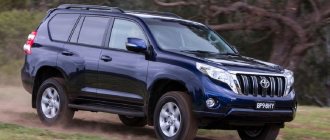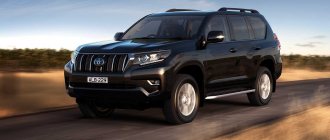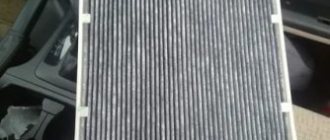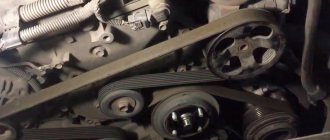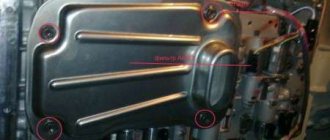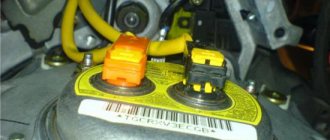Types of Toyota Land Cruiser 200 engines
Toyota Land Cruiser 200 is available with different types of engines. The most common is the 8 2UZ-FE with a volume of 4.7 liters, recognizable from other cars of this company. After the 2012 update, the 4.6-liter 1UR-FE with 309 hp became the leader. The Land Cruiser 200 received a 4.5-liter 1VD-FTV turbodiesel from the very beginning.
Auto mechanics are familiar with 2UZ-FE on the positive side. Starts great in cold weather, doesn't eat oil. One of the negative aspects is the dependence of the belt idler roller bearings on the presence or absence of protection from below. If it is not there, then they will break quite quickly with all the ensuing problems. A leaking pump can cause the belt to break. It is located deep in the camber of the cylinder block, attached to the timing drive and driven by a bending moment. The first problems can begin long before 100 thousand km. But it is not always possible to see this, only by looking at the level of antifreeze. It needs to be controlled! Otherwise, when the coolant crystallizes due to high temperatures, there is a risk of belt breakage.
1UR-FE with combined injection also appeared for the first time not on the TLC 200, but on the Lexus GS. Here it does not have double injectors; the gas distribution system, hollow camshafts and, unfortunately, problems similar to the 2UZ were left unchanged. The pump in the new 8 is started by a separate belt, but this does not prevent it from continuing to be a source of leaks and problems. In other respects, the new G8 is similar to the old one. It also has excellent starting qualities, no oil overeating and a good service life. Neither the hydraulic valve compensators nor the chain were let down, by which the definition of “long service life” more or less resembles reality.
It is surprising that the 1VD-FTV diesel engine also has a weak point - the water pump. It can work for a long time, but also loses its tightness up to 50 thousand km. Until 2009, this engine had another problem - oil consumption. True, the information on this is quite contradictory. There are those who complain, and there are those who don't. Dealers claim this consumption - approximately 1 liter per 2-3 thousand km. They blamed it either on the vacuum pump or on the piston rings. There are no official comments on this matter.
But in other respects, the diesel 8 with a cast iron block and two turbines is good. It doesn’t interfere with minor problems; it doesn’t have a particulate filter. The EGR just needs to be cleaned and refilled at decent gas stations. It’s nice that the fuel pump has a system for indicating whether it is dirty. To “renew” the element, simply remove the condensation. Separ will not be superfluous, but before installation it is worth finding out whether this will affect your warranty. However, I believe that this particular engine is the best and will have the least problems.
Source
Engines 100 Kruzak
The Land Cruiser 100 was equipped with: petrol V6 4.5 1FZ-FE and V8 4.7 2UZ-FE and diesel V6 1HZ-FE and V6 1HD-FTE. These engines have virtually no inherent problems , but time, improper maintenance and “high-quality” fuel and oil take their toll.
Engine Land Cruiser V6 4.5 1FZ-FE
The 4.5 liter Land Cruiser 1FZ-FE engine was produced between 1992 and 2009 . The internal combustion engine was modernized in 1998, then ignition coils were installed instead of the distributor. Main parameters of the power plant ( MT GX R2 ):
Judging by the parameters, one of the disadvantages is the impressive fuel consumption when moving around the city. Minor problems with oil leakage through gaskets and seals (if it is too liquid), as well as unstable idle (solved by adjusting the valves).
Diesel V6 1HZ-FE
The Land Cruiser SUV, popular in Japan, was equipped with a diesel engine labeled 1HZ-FE. The atmospheric 12-valve unit was produced with a single camshaft and was distinguished by its reliability.
The Land Cruiser 100 engine demonstrates the following characteristics:
Among the disadvantages, it is worth noting only the need to adjust the valves (after 50 thousand km), as well as the importance of replacing the belt already at 100 thousand km. Otherwise, the engine resource is high, subject to good maintenance.
Engine V6 1HD-FTE
The Land Cruiser 100 engine ( AT VX 50 package ) with the 1HD-FTE marking and a 4.2 displacement has the following characteristics:
List of main diesel problems:
Toyota Land Cruiser 200 timing belt or chain
Partisan
Group: Users Messages: 1 Registration: 7/28/2016 User No.: 24231
Good afternoon friends!
Approached the service at 150,000 km on a TLK 200, diesel Question: Do I need to change the timing chain and all the tension/deflection rollers. There is no noise, the condition is normal. And at what mileage is it necessary to change? Thank you!
Partisan
Group: Jeepers Messages: 25 Registration: 11.3.2013 From: Murmansk User No.: 20426
The AisinWPT-143 pump is the original one, the gasket for the pump and thermostat is included in the kit.
Experienced
Group: Jeepers Messages: 3884 Registration: 11/16/2010 Age: 43 From: Novorossiysk User No.: 13823
Good afternoon friends!
Approached the service at 150,000 km on a TLK 200, diesel Question: Do I need to change the timing chain and all the tension/deflection rollers. There is no noise, the condition is normal. And at what mileage is it necessary to change? Thank you!
Experienced
Group: Jeepers Messages: 3884 Registration: 11/16/2010 Age: 43 From: Novorossiysk User No.: 13823
Partisan
Group: Jeepers Messages: 25 Registration: 11.3.2013 From: Murmansk User No.: 20426
Partisan
Group: Jeepers Messages: 26 Registration: 3.9.2011 User No.: 16271
Experienced
Group: Jeepers Messages: 3884 Registration: 11/16/2010 Age: 43 From: Novorossiysk User No.: 13823
Partisan
Group: Jeepers Messages: 26 Registration: 3.9.2011 User No.: 16271
Communicative
Group: Jeepers Messages: 87 Registration: 12/21/2012 Age: 40 From: Novosibirsk User No.: 19922
Source
Consequences of untimely shift
When the drive is worn out, the engine begins to misfire. This is felt by a noticeable decrease in engine performance. The car slowly picks up speed or remains at low speed even when you press the gas pedal all the way.
If teeth fall off the drive, particles risk getting under other rotating elements, which will lead to deformation, rapid wear, or complete failure of the units. The camshaft pulleys may be damaged.
When a break occurs, the piston strokes cease to coordinate, and the cylinders begin to hit the valves, turning the engine into a device that cannot be restored.
Changing the timing belt in a Toyota is not at all difficult. The work is carried out with the vehicle standing on the ground. At the same time, dismantling the parts located around is quite simple, since the units and fasteners are in accessible places, and there is a lot of space under the hood
When changing this fundamental part of the power unit, it is extremely important to follow the sequence of installation of new spare parts. The pulleys must be fixed in accordance with the manufacturer's regulations, since these marks indicate the correct position of the camshafts
With thoughtful and leisurely work, replacing this part yourself will be successful and will ensure stable operation of your Toyota Hilux car.
Replacing the timing belt Toyota Land Cruiser 200
Before starting work, it is necessary to remove the cover over the internal combustion engine, the plastic panel over the radiator and the grille so as not to damage them. If a gas distribution apparatus is installed on the machine, you need to drain the antifreeze and free access to the belt.
Replacing the timing belt on a Land Cruiser 200 (gasoline) includes the following steps:
After assembling the mechanism, you need to run it to check its operation.
With an engine capacity (2UZFE) of 4.7 liters, there are 2 replacement options - with or without oil seals. The camshaft and crankshaft oil seals require replacement after 200,000 km. A complete replacement is recommended to prevent early maintenance due to leaking seals.
When replacing the timing belt on a Land Cruiser 200, it is recommended to immediately change the pump; its service life is also 150,000 - 200,000 km.
The standard timing belt replacement process does not require the installation of a new viscous coupling if it is in good condition to reduce maintenance costs.
Regeneration of the particulate filter using authorized Toyota Techstream equipment
If the car is used in a city environment, the regeneration program must be started manually by pressing the corresponding button on the dashboard. You should not forget about it, since burning is required regularly (approximately every 20-30 thousand kilometers). Sometimes it is best to entrust this procedure to specialists who use special diagnostic equipment.
This solution will have many advantages. At a minimum, the burning will be carried out by a qualified mechanic; at a maximum, he will monitor the exhaust temperature and the functioning of other systems, and also start reading error codes recorded by the engine’s electronic control module. The regeneration program operates on the principle of fuel combustion in injectors. The latter are installed on each of the cylinder heads.
This is what the diesel particulate filter matrix looks like for the Toyota Land Cruiser 200...
...And here you can see an indication of the need for burning.
Finally, it is important to prevent the injectors from clogging, since the engine will have to be removed to clean them. That is why we recommend that you regularly pamper yourself and your car with trips outside the city at high speed.
Labeling
On the Toyota Land Cruiser 200, the timing marks are set using a ratchet. You need to rotate the crankshaft using a ratchet bolt, without a pulley. According to the regulations, the marks on the timing gears must coincide with the engine mark. The alignment of the marks means that the first cylinder is at top dead center (TDC). They are graded by risk, not by “T.” According to the marks, you need to put on the belt so that the markings on it coincide with the “control” points.
The procedure is quite simple. The first time you can do it together with a mechanic at a service station, so as not to make mistakes when installing parts and reassembling.
Source
Timing marks
During repair work, it is necessary to install timing marks on the Land Cruiser 100 vehicle; it is needed in the following cases:
- after replacing the old mechanism with a new one;
- after complete or partial disassembly of the gas distribution system.
Steps for marking the mechanism and motor:
- Disconnect the battery.
- Raise the right wheel with a jack.
- Find the mark on the camshaft pulley.
- Now you need to find the same sign on the engine.
- Rotate the front wheel until the marks are aligned.
- Remove the flywheel plug.
- Check to see if the crankshaft mark matches the indicator on the engine block.
- If there is a discrepancy, continue rotating the wheel until they are completely connected to each other.
- Reassemble the structure in reverse order.
Operating a car, especially in poor road conditions, leads to the marks on the shaft and engine starting to move apart from each other. To avoid breakdowns associated with the gas distribution mechanism, which could later lead to an accident with the engine, it is recommended to check the location of the signs once a year.
The car owner must take into account that there will be less material costs for annual maintenance at a service station than for major engine repairs. Therefore, he will have to monitor the car, including in relation to the timing mechanisms.
Choosing a used Toyota Land Cruiser 200
The car is equipped with a developed stability control system, consisting of stabilizers adapted to driving conditions and an advanced anti-lock braking system. Optionally, electronically adjustable shock absorbers with a “memory” effect and a number of electronic assistants were offered, making it easier to use the car off-road. An important difference was the appearance of the Crawl Control system, which controls the engine and brakes off-road.
The fact that the “200” was not produced with a continuous front axle gave rise to some off-road fans to blame Toyota for “glamorizing” the SUV. But in practice, the off-road capabilities of the model are sufficient for a normal person with a huge margin.
When it entered the Russian market, the LC200 was offered in two slightly different trim levels: “Elegance” and “Lux”. The diesel version was supplied only in the “Lux” configuration.
In the base, the car was offered on 18” alloy wheels, with bi-xenon automatic optics, a parking assistance system and an all-round visibility system, four-zone climate control with dust filters, leather interior trim, an optitron instrument panel, and cruise control. The maximum configuration offered heated two rows of seats. The front seats were equipped with electric drive. The driver's seat has memory for three users.
Despite the popularity of the model, there is a shortage of offers on the secondary market for cars in good condition at an affordable price.
Today the car, at the time of its debut, was offered at prices from 2,200,000 for gasoline and from 2,212,000 rubles. for the diesel version, it is offered at a price of 1.5 million rubles. Cars from 2011 cost no less than 2.2 million rubles. and reach 3.3 million rubles. So, in practice, the “200” turned out to be an excellent anti-crisis investment!
Let’s clarify right away: there are no cars made in 2008 or even 2010 with a mileage of 100,000 km. The service center will tell you figures similar to reality when inspecting the condition of the body, interior, and chassis. Even the buyer himself can try to determine it by eye. By 120,000 km, the seam joints of the steering wheel trim begin to wear off, by 180,000 km, the leather over the entire surface of the steering wheel will wear off, and by 300,000 km, the steering wheel will be worn down to the ground. A rebuilt steering wheel indicates that the car has traveled at least 150-200 thousand km. A decent mileage is evidenced by the headlight glasses requiring polishing and the condition of the radiator.
Regardless of mileage, a car with a clean and clear service history will be the best choice.
Corrosion problems are found only on TLC200s that have undergone unprofessional body repairs using low-quality materials. On examples with an unsuccessful windshield replacement, there are pockets of corrosion in the upper part of the frame. This area is constantly exposed to sand, flying with the incoming air flow. In addition, if the glass replacement job is done poorly, aggressive anti-icing agents will flow behind the top molding. Sometimes this leak led to water getting into the electronic components, and these were the same cases of electrical problems that the TLC200 still occurs, although extremely rarely. Rust and “caries” near the glass frame can signal a very advanced corrosion process (with a transition to the racks) and here the buyer must decide whether he is ready to invest in a fairly extensive repair.
Engine Toyota 2UZ FE
In 1998, production of the second generation of engines of the uz family began. By the time the engine was launched, Toyota engineers and designers had accumulated a lot of experience in creating eight-cylinder internal combustion engines. Therefore, this power unit - 2UZ FE, is significantly different from its counterparts: the 1UZ FE and 3UZ FE engines. In addition to structural differences, this internal combustion engine uses several advanced, innovative technologies. All promising, innovative developments were created specifically for the 2UZ internal combustion engine, since it was intended for premium cars, Toyota and Lexus jeeps.
List of cars with 2UZ FE
During the period of mass production, this engine was installed on certain brands of cars in different countries of the world:
In the UAE 2UZ FE was installed:
- From September 2007 to March 2012 on Toyota Land Cruiser, eleventh generation, suv, body 100.
- From April 2005 to December 2007 on Toyota Land Cruiser, tenth generation, second restyling, suv, body 100.
- From August 2002 to March 2005 on Toyota Land Cruiser, tenth generation, restyling, suv, body 100.
- From January 1998 to July 2002 on Toyota Land Cruiser, tenth generation, suv, body 100;
In Russia, this engine was used:
- From September 2007 to March 2012 on the eleventh generation Toyota Land Cruiser, suv, 200 body.
- From April 2005 to December 2007 on the tenth generation Toyota Land Cruiser, second restyling, suv, body 100.
- From August 2002 to March 2005 on Toyota Land Cruiser, tenth generation, restyling, suv, body 100.
- From January 1998 to July 2002 on Toyota Land Cruiser, tenth generation, suv, body 100.
In Japan, 2uz was the heart:
- From September 2007 to December 2011 on Toyota Land Cruiser, eleventh generation, suv, body 200.
- From April 2005 to June 2007 on the tenth generation Toyota Land Cruiser, second restyling, suv, body 100.
- From August 2002 to March 2005 on Toyota Land Cruiser, tenth generation, suv, body 100.
- From January 1998 to July 2002 on the tenth generation Toyota Land Cruiser, suv, body 100.
In America, this motor was used:
- From April 2005 to October 2007 on the tenth generation Toyota Land Cruiser, second restyling, suv, body 100.
- From August 2002 to March 2005 on the tenth generation Toyota Land Cruiser, restyling, suv, body 100.
- From January 1998 to August 2002 on Toyota Land Cruiser, tenth generation, suv, body 100.
- From April 2005 to June 2007 on Toyota Land Cruiser Cygnus, first generation, second restyling, suv, J100 body.
- From August 2002 to March 2005 on Toyota Land Cruiser Cygnus, first generation, restyling, suv, J100 body.
- From December 1998 to July 2002 on the first generation Toyota Land Cruiser Cygnus, suv, J100 body.
- From November 2007 to January 2021 on the second generation Toyota Sequoia, suv, XK60 body.
- From August 2004 to December 2007 on Toyota Sequoia, first generation, restyling, suv, XK30 and XK40 body styles.
- From September 2000 to July 2004 on Toyota Sequoia, first generation, suv, XK30, XK40 bodies.
- From November 2006 to April 2009 on Toyota Tundra, second generation, pickup, XK50 body.
- From July 2002 to January 2007 on the first generation Toyota Tundra, restyling, pickup, XK30, XK40 bodies.
- From May 1999 to July 2002 on the first generation Toyota Tundra, pickup truck, XK30, XK40 bodies.
In addition, 2UZ FE was used:
- From August 2005 to August 2008, on Toyota 4Runner, fourth generation, restyling, suv, N210 body.
- From August 2002 to July 2005, on a Toyota 4Runner, fourth generation, suv, N210 body.
History of the creation and modifications of the Toyota 2 UZ FE internal combustion engine
Thanks to the widespread use of 1UZ FE, Toyota has collected a huge amount of research and statistical data in a short time. With so much experience gained, TOYOTA was able to quickly develop and mass produce the largest version of the UZ family of engines. It was a 4.7 liter 2UZ-FE power unit. Full-scale mass production of the new internal combustion engine began in 1998. This iron strongman was intended for high-end Toyota and Lexus SUVs.
The first version of 2uz was produced without the VVTi system. Production workshops for the production of this engine were located in two countries: Japan, the city of Tohara and the USA, Alabama. To suit its purpose, use on heavy SUVs and pickups, the engine block was made of cast iron. Other motors in the uz family use an aluminum block with thin-walled cast iron liners.
The cylinder diameter of the new engine is larger than in previous versions, it is 94 mm, and the piston stroke length is 84 mm. The compression ratio at 2uz was reduced to 9.6:1. These data for the motor are specially selected so that it can produce maximum torque at medium speeds. What the designers did well. So 2 UZ, the first version, without the VVTi system produces power at 4800 rpm equal to 230 hp, and peak torque at an average speed of 3600 rpm is 422 Nm.
In 2005, the second generation of UZ family engines was modernized. An updated modification, the intake camshaft received a system that changes valve timing, VVTi. In addition to this change, the throttle valve has undergone electronic control. Thanks to these modifications, the maximum power of 2uz fe with a phase regulator at 4800 rpm increased to 271 hp. And the maximum torque increased to 4400 Nm, at medium crankshaft speeds.
The production of the successful 2UZ FE power unit with a variable phase system and gas distribution mechanism continued until the end of 2010. Then it was replaced by more modern power units of the UR family.
It should be noted that cars using the engine in question have repeatedly won prizes in various competitions. The factors for multiple success were: high power, maximum torque at medium crankshaft speeds, moderate fuel consumption, low vibration and noise thresholds, compact placement of attachments. These characteristic features of the 2 UZ FE made the engine on the market at that time one of the best power units.
Technical data 2 UZFE
The largest engine in the UZ series is the second generation engine. The volume of its cylinders is 4664 cubic cm. This internal combustion engine was produced in Japan, Aichi Prefecture, the city of Tohara. The production of 2 uz was also carried out in America, Alabama, Toyota Motor Manufacturing.
- This is a gasoline, eight-cylinder, four-stroke engine with a V-shaped cylinder arrangement and a straight camber angle.
- The years of production of the engine of the first version without VVTi are from 1998 to 2005. The second version with an installed phase regulator was produced from 2005 to 2010.
- The material used to make the BC is a particularly durable cast iron alloy. This engine has two BC heads, each for four cylinders. Power supply system 2UZ injector, electronic multi-point injection. The operating temperature of the internal combustion engine is 90C.
- Timing system - DOHC, four camshafts, two for each head, 32 valves, four for each cylinder. The timing system after 2005 is equipped with a phase regulator. There are no hydraulic compensators in the timing system. The ignition system is independent, electronic, each cylinder has an individual ignition coil.
- The piston stroke length is less than the cylinder diameter of 84 and 94 mm, the compression ratio is 9.6:1. The power of the power unit, without the VVTi system, at 4800 rpm, is 230 Nm, peak torque at 3600 rpm, about 420 Nm. The 2UZ engine with a phase regulator has a power of 271 hp, force and torque of 440 Nm, at the same crankshaft speed.
Fuel consumption
Compliance with environmental standards for emissions of harmful substances Euro 2, Euro 3. The weight of the power plant is 245 kg. Recommended fuel is AI 95 gasoline. Fuel consumption during city driving is 16.5 liters per 100 km, mileage, when driving on the highway 10 liters, total consumption is 12.5 liters per 100 km, mileage.
Oil consumption
The permissible consumption of motor lubricant is about 1 liter per 1000 km, mileage. Types of oil used: 0w30, 5w40, 10w40, 5w30, 10w30. The amount of oil in the crankcase is 6.2 liters. Engine lubricant must be replaced no later than after 10 thousand km. But it is better, for a longer engine life, to change the oil after 5000 km.
Engine life
The resource of 2UZ FE is 500 thousand, km, mileage. With good maintenance and careful operation, it can significantly exceed official data.
Marking of Japanese internal combustion engines
The name of all Japanese engines has a certain marking consisting of numbers and Latin letters. Each symbol, in its specific place, has specific information about the power unit in question.
Let's look at the marking of internal combustion engines using the example of 2UZ FE:
- the number always comes first, it means the generation of engines of this series, here it is the second generation;
- Next come two symbols, in the form of capital Latin letters. They mean the ICE family. In our case, the motor is of the UZ family. Where U is the line of power units, and Z indicates the fuel used - gasoline;
- The following characters are Latin capital letters, there may be three or two. They encode the features of the car and its performance;
- the F symbol informs about the timing system used on the engine in question. Here it is a DOHC system consisting of two heads, each containing two overhead camshafts and 32 valves. There are no hydraulic compensators, the VVTi system has been used since 2005;
- The last symbol in the name, E, informs about the electronic, multi-point injection used on this engine.
Having collected all the information, we can say that the internal combustion engine in question is the second generation, UZ family, uses gasoline fuel, is equipped with a timing system - DOHC, and electronic injection.
Description of ICE 2UZ FE
At the end of the nineties, the demand for powerful engines increased. In this regard, Toyota engineers have developed a new gasoline engine, with the largest volume of the UZ family. In 1998, serial production of the new model began. The 2 UZ FE power unit was intended for use in heavy jeeps and powerful sports cars. Gradually, this eighth engine forced the six-cylinder, in-line 1FE engine out of the market. Unlike other motors of the UZ family, the second generation received a cast iron block; such a motor housing was a guarantee of durability and reliability.
The cylinders of the new internal combustion engine have a diameter of 94 mm. The crankshaft of the power unit provided a piston stroke of 84 mm. The result was a very successful low-end engine with a cylinder capacity of 4.7 liters.
Despite the cast iron block, the BC heads are still made of aluminum alloy. The engine uses two symmetrical heads, each for four cylinders on one side. The heads contain two overhead shafts; each cylinder has 4 valves. The motor in question has two versions. The first version of 2UZ FE was produced until 2005.
Then the engine was modified and a VVTi system was installed on it. With a system for changing gas distribution phases, the engine began to produce 271 hp. Although without a phase regulator, this engine developed a power not exceeding 230 hp. Both versions of 2UZ do not have hydraulic compensators. Adjustment of thermal clearances in valves should be carried out by selecting washers. The adjustment period is about 100 thousand km. If knocking occurs in the upper part of the engine, the thermal clearance in the valves needs to be adjusted earlier.
On the engine in question, the timing drive mechanism is carried out by a timing belt from the crankshaft toothed pulley. The torque is transmitted to the intake camshaft toothed pulley. The exhaust camshaft is driven by the intake shaft through a gear transmission. It should be noted that in addition to the timing drive, the belt drives the water pump. Thus, being subjected to double load. Therefore, experienced mechanics do not recommend trusting timing belt manufacturers who guarantee a service life of their product of 100 thousand km. There are quite a few cases where the belt became unusable long before this mileage. Therefore, it makes sense to reduce the timing belt replacement period to 60 thousand kilometers.
Serial production of the 4.7 liter internal combustion engine successfully continued until 2011. Then it gave way to the more environmentally friendly and modern 1UR FE on the main conveyor.
Typical faults
The power unit of the second generation of the UZ family is rightfully considered one of the most successfully designed and assembled engines, not only of this family. The only thing, in the opinion of experienced mechanics, that contributed to its replacement with UR series motors was the failure to comply with high European requirements for emissions of harmful substances into the atmosphere.
The engine is so ideal that with careful and timely maintenance, as well as adequate driving, there is no need to talk about shortcomings and breakdowns at all.
The engine simply does not have any technical miscalculations, defects or quickly wearing parts. When using high-quality, appropriate oil and using gasoline without unnecessary impurities, of the appropriate brand, as well as proper, timely maintenance, the resource of the power unit far exceeds half a million kilometers. It must be taken into account that in this case, we are not only talking about some kind of serious repairs, but even minor malfunctions are not worth talking about.
Innovative technologies on the 2UZ FE internal combustion engine
When carrying out the task of designing a power unit for prestigious Toyota SUVs, the company's designers tried to create a powerful and at the same time economical engine with low noise levels. To solve this problem, a number of new innovative technologies were used:
Compressor
In order to increase the power of the power unit, the TRD (Toyota Racing Development) company installs a compressor kit - a mechanical supercharger - on the 4.7 liter engine. This innovative part increases the power of this engine to 350 hp. And what is important, this modernization does not reduce the service life and reliability of the motor in question;
The 2UZ uses the Electronic Throttle Control System. ETCS is an intelligent, electronic system that controls throttle position. This system significantly improves control over the operation of the power unit, especially in off-road conditions and under extreme driving conditions, thereby ensuring comfort and ease of driving in all driving situations;
Starter Control System
The Starter Control System was used for the first time on the engine in question. This is the system that controls the activation of the starter. It keeps the starter from starting until a special sensor determines the readiness of the combustible mixture in the combustion chambers for ignition. This system helps to increase engine reliability and increases the service life of the starter;
Toyota Direct Ignition
The 2UZ used a directional ignition system, Toyota Direct Ignition, or TDI for short. This system contributes to the accuracy and reliability of the ignition angle advance, which guarantees complete and better combustion of the combustible mixture. And this is directly related to improving the environmental friendliness and efficiency of the power unit.
Features of operational maintenance
All engines of the UZ family are an example of minimalism and unpretentiousness in maintenance. The 2UZ FE engine discussed here is no exception. But no matter how unpretentious the engine is, the quality and duration of its operation depends on the correctness and timeliness of its maintenance.
Replacing spark plugs on 2UZ FE
Recommended oil change schedule
Necessary measures for all jeeps and pickups on which such a motor is installed include replacing motor lubrication and oil filters. The manufacturer recommends performing this operation every 10 thousand km, and using only oil recommended by the manufacturer. However, it is not a fact that the oil purchased, even in a specialized store, is genuine.
And if the oil is of dubious production, then by 10 thousand km, not a trace will remain of its lubricating properties. Engine parts in contact will remain unprotected and will quickly fail. Which can lead to complex, expensive repairs.
Adjusting valves on 2UZ-FE
Minimum oil change period
To prevent this from happening, it makes sense to carry out oil change measures after 5 thousand km. Even if the motor lubricant turns out to be fake, up to 5000 km, the mileage of the lubricating properties will remain sufficient to protect the rubbing parts of the power unit. Reducing the oil change period by half guarantees the protection of engine parts in any, even the most severe conditions.
Replacing the timing belt
An important measure for engine maintenance is replacing the timing belt. The service life of the timing belt, declared by the manufacturer, is 100 thousand km. However, the belt rotates not only the camshaft; it is common to all attachments. This means that it can jump or burst with less mileage than 100 thousand km.
This is especially dangerous on engines manufactured after 2005 with the VVTi system. These power units, when the timing belt breaks, deform the valves. Therefore, the installation of a new belt must be performed no later than after 60 thousand km. Replacing a belt is a complex undertaking that requires experience and knowledge. It is better to carry out this work in a specialized workshop, where experienced professionals work.
According to the manufacturer’s recommendations, other internal combustion engine maintenance procedures must be performed in a timely manner. Such as: replacing fuel and air filters, working fluids and other consumables. Correct implementation of the above measures guarantees long-term and emergency-free operation of this internal combustion engine.

